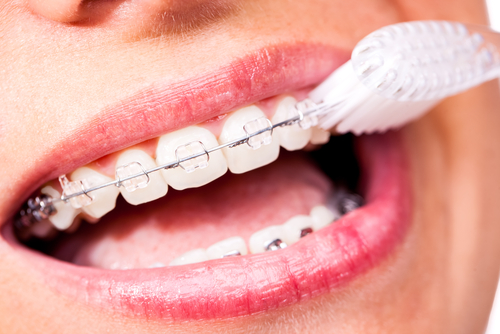“Go brush really well while you have your wires out”, I often hear doctors and assistants say when visiting offices.
It sounds harmless enough but what are we really saying to our patients?
“You can’t possibly brush well with your wires in so don’t worry about doing a good job”, is what I hear and it’s what the patients hear as well. Instead, we should be encouraging patients to learn to “brush really well” while they have their wires in because that is the condition in which they find themselves 99.999999 percent of the time while in braces. I’m sure the very first doctor who decided that having patients brush with wires out meant well and I’m sure that the rest of us who have blindly copied this for decades didn’t realize what we were doing but it’s time to stop. Want another reason to stop suggesting patients brush with their wires out? OK, doing so is terrible for the efficiency of your office and massively increases your chair time per patient. Think about it!
Now, before you say, “My patients want to brush with their wires out”, think carefully. While there are a very few outliers who are usually excellent brushers (and adults) who ask and even demand to do so (and of course we let them), most patients do not request this efficiency-sapping outing until we train them to do so.
Stop teaching patients that they can only do a good job brushing with the wires out. It’s good for you and good for them!
While I’m on the subject, I would also appreciate it if we, as a profession, would stop teaching patients that time spent brushing is more important than technique or results. What do I mean? Well just look inside the kit you give patients at the bond appointment and listen to the assistants when they give hygiene instructions. You’re bound to hear the assistants tell patients that they should brush for two minutes and those stupid little hour glasses that count off 2 minutes are everywhere. Where did 2 minutes come from? What does 120 seconds have to do with anything? How did it happen that a profession filled with such intelligent people blindly adopted 2 minutes as the gold standard? Why do we tell every single patient that if they brush for 2 minutes they are good to go?
What should we tell patients? I’m glad you asked. There are many things that work well. Here are a few suggestions:
Brush until your teeth are clean and there is no plaque. Let me show you what that looks like…
Make sure to brush above and below the braces and angle the brush towards the brackets like this…
Brush with the toothbrush half on the gums and half on the teeth like this…
I know most patients won’t floss every day with braces on but at least use an electric flosser every day and try to floss properly at least a couple times a week. Put it on your calendar on your phone. Here is how you use floss threaders…
Use a tongue scraper like this…
Take a video of what I’m demonstrating on your phone so you can look at it later….
Use these examples, copy others or make up your own. The most important thing is to figure out what the patient you are talking to likes and dislikes and relate the need to brush to something the patient cares about. I can’t give you examples or scripting for everyone but an easy one that works for most teens and even preteens is some variation of, “Those good looking girls/boys tend to look at your teeth and gums and they are really put off by nasty teeth and bad breath. I’ve seen it so make sure you’re not that guy/gal.”
There are a million ways to get patients to brush and you have to figure out which one works for you and the patient you’re talking to at that moment. You can do it! Experiment and make it fun because doing the same thing over and over while expecting a different result is the definition of insanity.


Great stuff! Love the taking a video w/ the phone.
We love to use that when kids say they can’t remember how to do things like brush or wear elastics